| "Tremendous Efforts Are Being Made For Fighting Cancer Of
All Types" |
| May 4,
1961 |
Bradenton Herald |
May 5, 1961 |
|
|
Scroll down to read full text of article |
|
| |
|
| |
|
| |
|
| |
|
| |
|
| |
|
| |
|
| |
|
| |
|
| |
|
| |
|
| |
|
| |
|
| |
|
| |
|
| |
|
| |
|
| |
|
| |
Transcription from microfilm |
| |
for historical purposes |
| |
by Edward T. Haslam, Dec. 2008 |
| |
|
| |
|

|
|
(Editor's note: The follow- |
| |
ing manuscript was submit- |
| |
ted to The Herald by Judy |
| |
Vary, outstanding young |
| |
science student of Manatee |
| |
High School. Judy is special- |
| |
izing on cancer reseaerch and |
| |
she said the article, prepared |
| |
by experts, soon will appear |
| |
in the National Biological |
| |
Teachers Association mag- |
| |
azine). |
| |
|
| |
Someday, we are told, cancer |
| |
will join the long ranks of |
| |
completely - curable diseases. |
| |
Someday, we are promised, |
| |
there will be found a cure for |
| |
cancer of all kinds. But few of |
| |
us realize the tremendous ef- |
| |
forts being made against the |
| |
dread disease in the many lab- |
| |
oratories and hospitals through- |
| |
out the country, or of the mil- |
| |
lions of man-hours being spent |
| |
everywhere by dedicated men |
| |
and women who are doing their |
| |
best to find some of the an- |
| |
swers to our nation's second- |
| |
greatest killer-disease. |
| |
The results of such work are |
| |
sometimes, even often, disap- |
| |
pointing, but progress is now
be- |
| |
ing made at an ever-increasing |
| |
rate. For example, children with |
| |
leukemia could be expected to |
| |
live only as long as five or six |
| |
months with optimum treatments |
| |
a few years ago. Now some sur- |
| |
vive as long as five years with |
| |
various new treatments, such as |
| |
the injection of cancer-recessor |
| |
drugs - drugs which regress leu- |
| |
kemic activity for ever
increasing |
| |
periods of time - in the
patient. |
| |
Some of the advances against |
| |
cancer were recently released
for |
| |
the first time to the press by |
| |
the top research scientists in
the |
| |
nation last month where the |
| |
Doctor's Motel at St. Petersburg |
| |
was host to the annual Science |
| |
Writers' Seminar sponsored by |
| |
the American Cancer Society. |
| |
Newsmen from every major news- |
| |
paper in the United States were |
| |
present at the exclusive confer- |
| |
ence. Many of the findings pre- |
| |
sented were dramatically encour- |
| |
aging, pointing to a possible
cure |
| |
for cancer within the next few |
| |
decades. |
| |
|
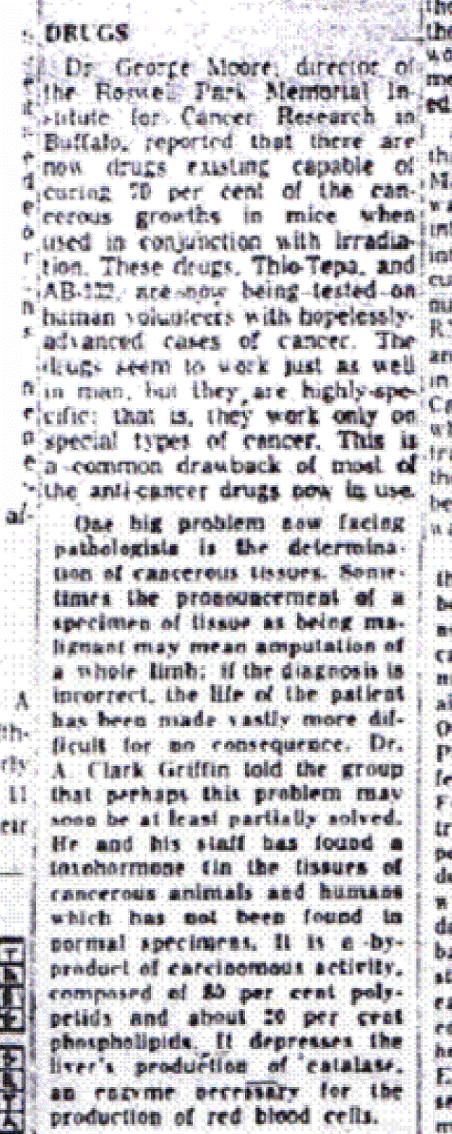
|
|
|
| |
DRUGS |
| |
Dr. George Moore, director of |
| |
the Roswell Park Memorial In- |
| |
stitute for Cancer Research in |
| |
Buffalo, reported that there are |
| |
now drugs existing capable of |
| |
curing 70 per cent of the can- |
| |
cerous growths in mice when |
| |
used in conjustion with irradia- |
| |
tion. These drugs, Thio-Tepa and |
| |
AB-112, are now being tested on |
| |
human volunteers with
hopelessly- |
| |
advanced cases of cancer. The |
| |
drugs seem to work just as well |
| |
in men, but they are highly-spe- |
| |
cific: that is, they work only
on |
| |
special types of cancer. This is |
| |
a common drawback of most of |
| |
the anti-cancer drugs now in
uses. |
| |
One big problem now facing |
| |
pathologists is the determina- |
| |
tion of cancerous tissues. Some- |
| |
times the pronouncement of a |
| |
specimen of tissue as being ma- |
| |
lignant may mean amputation of |
| |
a whole limb; if the diagnosis
is |
| |
incorrect, the life of the
patient |
| |
has been made vastly more dif- |
| |
ficult for no consequence. Dr. |
| |
A. Clark Griffin to the group |
| |
that perhaps this problem may |
| |
soon be at least partially
solved. |
| |
He and his staff has found a |
| |
toxohormone in the tissues of |
| |
cancerous animals and humans |
| |
which has not been found in |
| |
normal specimens. It is a by- |
| |
product of carcinomous activity, |
| |
composed of 85 percent poly- |
| |
peptides and about 20 percent |
| |
phosphollpids. It depresses the |
| |
liver's production of catalase
- |
| |
an enzyme necessary for the |
| |
production of red blood cells. |
| |
|
| |
|
| |
|
| |
|

|
|
|
| |
EFFECTS |
| |
Many of the drugs which could |
| |
be successfully used in
anti-can- |
| |
cer therapy cannot be adminis- |
| |
tered because of the dangerous |
| |
toxic effects on sensitive
organs |
| |
or tissues in the body which are |
| |
non-cancerous. Dr. Claude Hitch- |
| |
cock and his associates from
Min- |
| |
neapolis General Hospital told
of |
| |
the special surgical procedures
in- |
| |
volving hypothermia, a rapid
lower- |
| |
ing of body or tissue's normal |
| |
temperature to slightly above |
| |
freezing point, drainage of
fluids |
| |
and perfusion of the removed or- |
| |
gan with anti-cancer drugs. Kid- |
| |
neys, for example, were removed |
| |
from living baboons,
"frozen," |
| |
perfused, slowly
"thawed," and |
| |
replaced in the anesthetized
ani- |
| |
mal after up to 18 hours with |
| |
no apparent ill effects. The po- |
| |
tentials involved are enormous. |
| |
Consider, for example, cancer of |
| |
the lung being treated by
removal |
| |
of the lung and complete
eradica- |
| |
tion of the cancer by means of |
| |
drugs which would normally pois- |
| |
on the whole body dangerously. |
| |
The lung could be replaced in
the |
| |
body whenever the patient would |
| |
be strong enough to undergo a |
| |
second operation safely, or, if
pos- |
| |
sible, the treated organ could
be |
| |
replaced as soon as a few hours! |
| |
The day may come when whole |
| |
brains could be transplanted by |
| |
such a method. |
| |
|
| |
|
| |
|
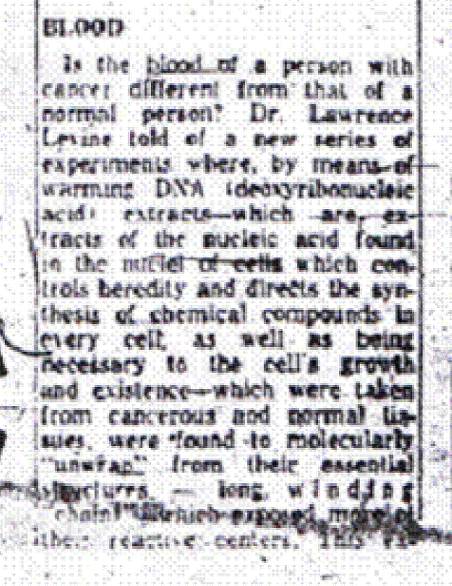
|
|
BLOOD |
| |
Is the blood of a person with |
| |
cancer different from that of a |
| |
normal person? Dr. Lawrence |
| |
Levine told of a new series of |
| |
experiments where, by means of |
| |
warming DNA (deoxyribonuclaic |
| |
acid) extracts - which are ex- |
| |
tracts of the nucleic acid found |
| |
in the nuclei of cells which
con- |
| |
trols heredity and directs the
syn- |
| |
thesis of chemical compounds in |
| |
every cell, as well as being |
| |
necessary to the cell's growth |
| |
and existence - which were taken |
| |
from cancerous and normal tis- |
| |
sues, were found to molecularly |
| |
"unwrap" from their
essential |
| |
structures - long, winding |
| |
chains which-exposed more of |
| |
their reactive centers. This ex- |
| |
|
| |
|
| |
|
| |
|
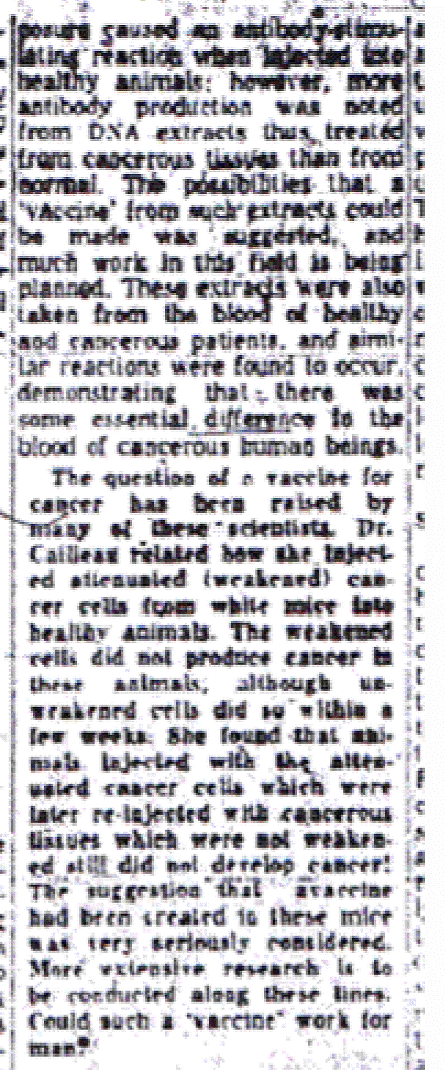
|
|
posure caused an antibody-stimu |
| |
lating reaction when injected
into |
| |
healthy animals; however, more |
| |
antibody production was noted |
| |
from DNA extracts thus treated |
| |
from cancerous tissues than from |
| |
normal. The possibilities that a |
| |
"vaccine" from such
extracts could |
| |
be made was suggested, and |
| |
much work in this field is being |
| |
planned. These extracts were also |
| |
taken from the blood of healthy |
| |
and cancerous patients, and
simi- |
| |
lar reactions were found to
occur, |
| |
demonstrating that there was
some |
| |
essential difference to the |
| |
blood of cancerous human beings. |
| |
The question of a vaccine for |
| |
cancer has been raised by |
| |
many of these scientists. Dr. |
| |
Caitleau related how she inject- |
| |
ed attenuated (weakened) can- |
| |
cer cells from white mice into |
| |
healthy animals. The weakened |
| |
cells did not produce cancer in |
| |
these animals, although un- |
| |
weakened cells did so within a |
| |
few weeks. She found that ani- |
| |
mals injected with the atten- |
| |
uated cancer cells which were |
| |
later re-injected with cancerous |
| |
tissues which were not weaken- |
| |
ed, still did not develop
cancer! |
| |
The suggestion that a vaccine |
| |
had been created in these mice |
| |
was very seriously considered. |
| |
More extensive research is to |
| |
be conducted along these lines. |
| |
Could such a "vaccine"
work for |
| |
man? |
| |
|
| |
|
| |
|
| |
|
| |
|
| |
|
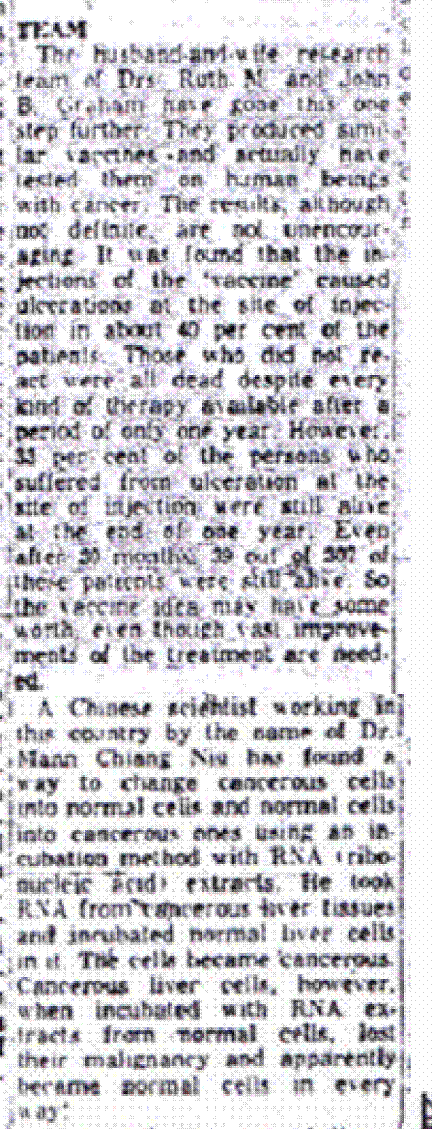
|
|
|
| |
TEAM |
| |
The husband and wife research |
| |
team of Drs. Ruth M. and John |
| |
B. Graham have gone this one |
| |
step further. They produced simi- |
| |
lar vaccines - and actually have |
| |
tested them on human beings |
| |
with cancer. The results, although |
| |
not definite, are not unencour- |
| |
aging. It was found that the in- |
| |
jections of the
"vaccine" caused |
| |
alterations at the site of
injec- |
| |
tion in about 40 per cent of the |
| |
patients. Those who did not re- |
| |
act were all dead despite every |
| |
kind of therapy available after
a |
| |
period of only one year. However, |
| |
33 per cent of the persons who |
| |
suffered from ulceration at the |
| |
site of injection were still
alive |
| |
at the end of one year. Even |
| |
after 30 months, 39 out of 307
of |
| |
these patient were still
alive. So |
| |
the vaccine idea may have some |
| |
worth even though vast improve- |
| |
ments of the treatment are need |
| |
ed. |
| |
A Chinese scientist working in |
| |
this country by the name of Dr. |
| |
Mann Chiang Niu has found a |
| |
way to change cancerous cells |
| |
into normal cells and normal
cells |
| |
into cancerous ones using an in- |
| |
cubation method with RNA (ribo- |
| |
nucleic acid) extracts. He took |
| |
RNA from cancerous liver tissues |
| |
and incubated normal liver cells |
| |
in it. The cells became cancerous. |
| |
Cancerous liver cells, however, |
| |
when incubated with RNA ex- |
| |
tracts from normal cells, lost |
| |
their malignancy and apparently |
| |
became normal cells in every |
| |
way. |
| |
|
| |
|
| |
|
| |
|
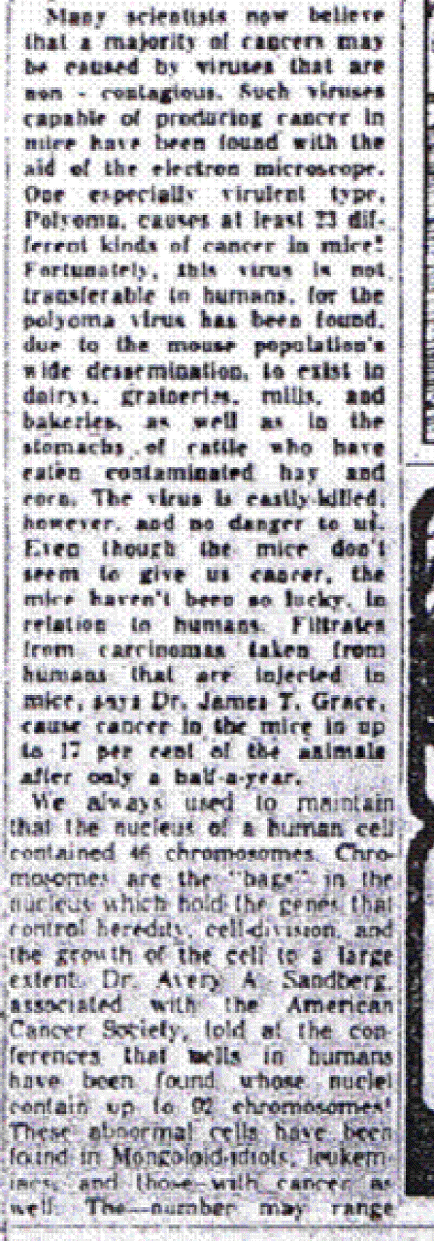
|
|
Many scientists now believe |
| |
that a majority of cancers may |
| |
be caused by viruses that are |
| |
non-contagious. Such viruses |
| |
capable of producing cancer in |
| |
mice have been found with the |
| |
aid of the electron microscope. |
| |
One especially virulent type, |
| |
Polyoma, causes at least 23 dif- |
| |
ferent kinds of cancer in mice!! |
| |
Fortunately, this virus is not |
| |
transferable in humans, for the |
| |
polyoma virus has be found, |
| |
due to the mouse population's |
| |
wide desemination, to exist in |
| |
dairys, graineries, mills, and |
| |
bakeries, as well as in the |
| |
stomachs of cattle who have |
| |
eaten comtaminated hay and |
| |
corn. The virus is easily killed, |
| |
however, and no danger to us. |
| |
Even though the mice don't |
| |
seem to give us cancer, the |
| |
mice haven't been so lucky, in |
| |
relation to humans. Filtrates |
| |
from carcinomas taken from |
| |
humans that are injected in |
| |
mice, says Dr. James T. Grace, |
| |
cause cancer in the mice in up |
| |
to 17 per cent of the animals |
| |
after only a half-a-year. |
| |
We always used to maintain |
| |
that the nucleus of a human cell |
| |
contained 46 chromosomes. Chro- |
| |
mosomes are the "bags"
in the |
| |
nucleus which hold the genes
that |
| |
control heredity, cell-division,
and |
| |
the growth of the cell to a
large |
| |
extent. Dr. Avery A. Sandberg, |
| |
associated with the American |
| |
Cancer Society, told us the con- |
| |
ferences that cells in humans |
| |
have been found whose nuclei |
| |
contain up to 92 chromosomes! |
| |
These abnormal cells have been |
| |
found in Mongoloid idiots,
leukem- |
| |
ians and those with cancer as |
| |
well. The number may range |
| |
|
| |
|
| |
|
| |
|
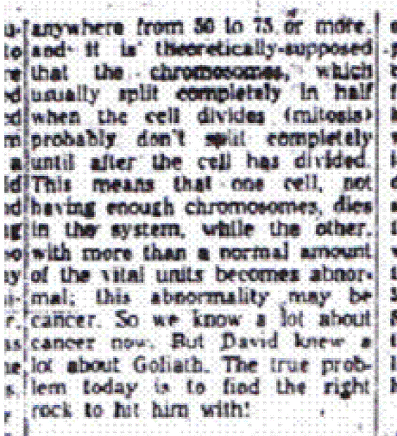
|
|
anywhere from 50 to 75 or more, |
| |
and it is theoretically-supposed |
| |
that the chromosomes, which |
| |
usually split completely in half |
| |
when the cell divides (mitosis) |
| |
probably don't split completely |
| |
until after the cell has
divided. |
| |
This means that one cell, not |
| |
having enough chromosomes, dies |
| |
in the systems, while the other, |
| |
with more than a normal amout |
| |
of the vital units becomes
abnor- |
| |
mal; this abnormality may be |
| |
cancer. So we know a lot about |
| |
cancer now. But David knew a |
| |
lot about Goliath. The true prob- |
| |
lem today is to find the right |
| |
rock to hit him with! |
| |
|
| |
|
| |
|

|
|
STUDY |
| |
Carcinogens - cancer-producing |
| |
or inducing substances, are now |
| |
being studied to determine how |
| |
they affect the cell to make it |
| |
cancerous. There are several |
| |
theories, but most are linked to |
| |
the chromosome explanation and |
| |
the two nucleic acids found in |
| |
the heart of the cell - DNA and |
| |
RNA. Dr. Emmanuel Farber has |
| |
concluded after extensive re- |
| |
search that carcinogens probably |
| |
act on nucleotid segments of the |
| |
nucleic acid molecules,
particular- |
| |
ly those of DNA. The reaction to |
| |
the carcinogens causes bizarre |
| |
changes in the chain-like compo- |
| |
sition of the acids, making them |
| |
resemble molecular struc- |
| |
tures found in a virus nucleic |
| |
acid that is capable of
producing |
| |
cancer in mice. The doctor be- |
| |
lieves that the carcinogens -
tars, |
| |
oils, cigarette smoke, arsenic, |
| |
etc. - cause aberrations similar
to |
| |
those induced by viruses or
radia- |
| |
tion in the cell, eventually
causing |
| |
cancer due to this alteration in |
| |
the basic elements of the cell's |
| |
nucleotid structures. |
| |
Probably the most interesting |
| |
study on carcinogenic agents |
| |
was conducted by Dr. D. Caylee |
| |
Hammond of the Statistical Re- |
| |
search section of the ACS. His |
| |
work with 13, 068 persons in re- |
| |
lation to the smoking habits |
| |
and the effects of smoking was |
| |
laterpreted at the seminar. |
| |
Some very auspicious fingers |
| |
now seem to point out that |
| |
smoking causes cancer. Fur- |
| |
ther, filters seem to hlep very |
| |
little. Some of the answers |
| |
given for the questionaires were |
| |
significant. For example, 26.2 |
| |
per cent of smokers who |
| |
smokes two packs of cigarettes |
| |
a day complained of nervous |
| |
tension, while onle 7.2 per cent |
| |
|
| |
|
| |
|
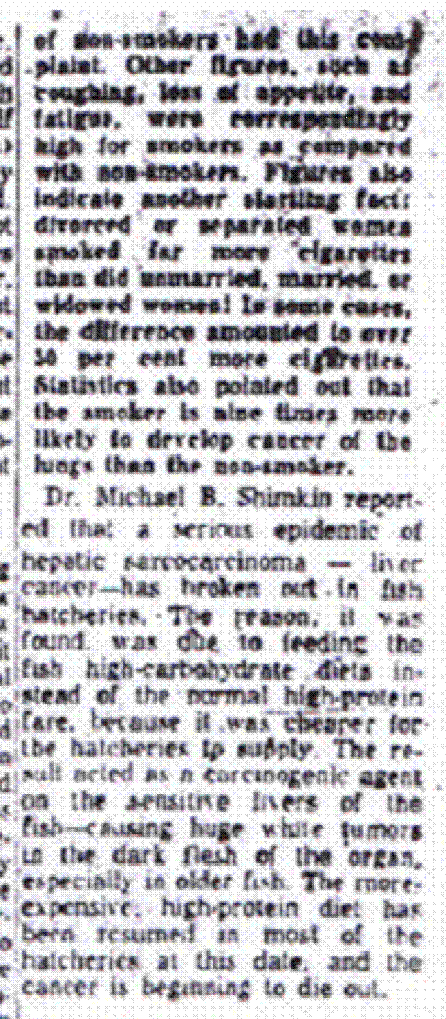
|
|
of non-smokers had this com- |
| |
plaint. Other figures, such as |
| |
coughing, loss of appetite, and |
| |
fatigue, were correspondingly |
| |
high for smokers as compared |
| |
with non-smokers. Figures aslo |
| |
indicate another startling fact: |
| |
divorced or separated women |
| |
smoked far more cigarettes |
| |
than did unmarried, married, or |
| |
widowed women! In some cases, |
| |
the difference amounted to over |
| |
36 per cent more cigarettes. |
| |
Statistics also pointed out that |
| |
the smoker is nine times more |
| |
likely to develop cancer of the |
| |
lungs than the non-smoker |
| |
Dr. Michael B. Shimkin report- |
| |
ed that a serious epidemic of |
| |
hepatic sarcocarcinoma - liver |
| |
cancer - has broken out in fish |
| |
hatcheries. The reason, it was |
| |
found, was due to feeding the |
| |
fish high-carbohydrate diets in- |
| |
stead of the normal high-protein |
| |
fare, because it was cheaper for |
| |
the hatcheries to supply. The re- |
| |
sult acted as a carcinogenic
agent |
| |
on the sensitive livers of the |
| |
fish - causing huge white tumors |
| |
in the dark flesh of the organ, |
| |
especially in older fish. The more- |
| |
expensive, high-protein diet has |
| |
been resumed in most of the |
| |
hatcheries at this date, and the |
| |
cancer is beginning to die out. |
| |
|
| |
|
| |
|
| |
|

|
|
|
| |
EDUCATIONAL |
| |
The entire seminar was a most |
| |
educational, intellectually
stim- |
| |
ulating, and enjoyable
affair! It |
| |
is extremely difficult to even
re- |
| |
late half of the discoveries re- |
| |
leased to the public for the
first |
| |
time, and this outline is of
neces- |
| |
sity inadequate. But the fact that |
| |
these discoveries are taking
place - |
| |
and there are so many! - only |
| |
means that the battle against |
| |
cancer - man's most ancient and |
| |
painful enemy - is being waged |
| |
harder than ever. We're close to |
| |
a final answer to cancer -
perhaps |
| |
within the next two or three |
| |
decades or even sooner. But it |
| |
takes cooperation, facilities, |
| |
funds. We all can't don a white |
| |
coat and work in a laboratory, |
| |
but we all can help the battle |
| |
against cancer by giving gen- |
| |
erously to the American Cancer |
| |
Society: which sponsors these |
| |
vitally important
activities. Re- |
| |
member more persons have died |
| |
from cancer in the last 50 years |
| |
than from all of history's
great |
| |
wars. It's up to you to fight |
| |
cancer - with a "check up -
and a |
| |
check!!!" |
| |
|
| |
|
| |
|
| |
|
| |
|
| |
|
| |
|
| |
|
| |
|
| |
|
|
|
|

























